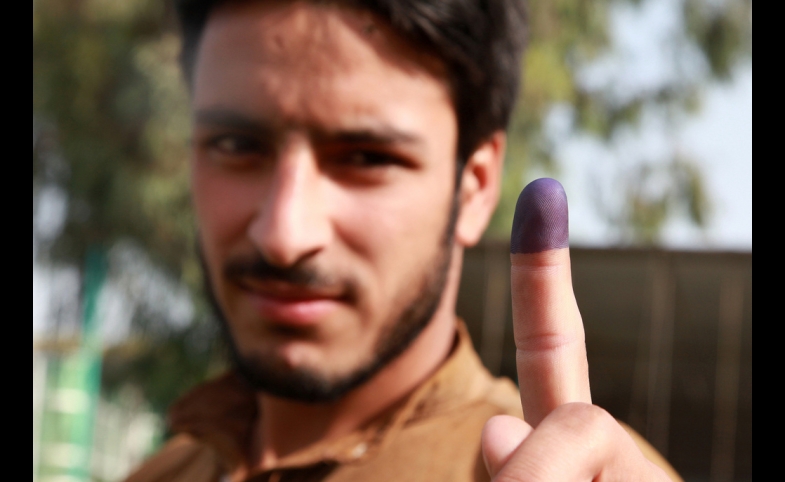It would seem impossible for the Taliban to get good publicity in Western media, but the unthinkable nearly happened on December 16, 2014. How? The Taliban tricked the press by using a powerful communications technique: the...
KEEP READINGThe CPD Blog is intended to stimulate dialog among scholars and practitioners from around the world in the public diplomacy sphere. The opinions represented here are the authors' own and do not necessarily reflect CPD's views. For blogger guidelines, click here.

The Afghan Elections: A Counterinsurgency Perspective
According to counterinsurgency strategist David Galula, the clearest way to take support away from an insurgent is to hold successful elections. Elections are the most visible way a population demonstrates their choice for the government rather than the insurgent. I made such an observation during the Afghan Presidential election.
During the first round of elections in April, I was deployed in Regional Command-South for the International Security Assistance Force as an Afghan Hand Advisor to the Afghan Army, Provincial Police and the Kandahar Media Information Center (KMIC). During the second round, I moved back to Kabul and was embedded in the Multi-Ministry News Desk with public affairs personnel from the Afghan Security Ministries and the Independent League of Local Governance. I worked alongside my Afghan partners to both observe and continue the flow of the global conversation that unfolded during the elections. In Kandahar, once the epicenter of the Taliban insurgency, there were no insurgent attacks. As one reporter tweeted on Tolo: in 2009 the city had 30 explosions, this year there were none.
The support was not only for a new Afghan government, but the security forces that protected the voters. Even in the cases in which polling stations were attacked, the Afghan voters got back in line to defy the Taliban. This was a story told by the Afghan people thanks to the rapid expansion of the use of social media and internet connectivity. According to the U.S. Institute of Peace, there are now four telecom companies offering 3G services, boosting internet access through mobile broadband to a penetration rate of 89%. During this year’s elections, all candidates used Facebook and Twitter. Social media also gave political candidates access to young Afghans who make up 68% of the voting bloc.
Additionally, if one Afghan or international journalist had a smart phone with internet access in a village or district, that person became the voice of that village or district in a global conversation. For example, one tweet that went viral showed an elderly Afghan woman holding up her purple ink stained finger with the quote, "I use this hand to vote and the other to slap the Taliban."
One reason for the overwhelmingly positive coverage is the Taliban's killing of Afghan and international journalists before the elections. The murders sent shockwaves through the Afghan and international journalist communities. Many journalists then vowed not to report Taliban attacks to deny media exposure. March 21, Afghan journalist Sardar Ahmad was shot with his family by Taliban gunmen at the Serena Hotel in Kabul, while celebrating the Persian New Year. In addition, Anja Niedringhaus, an internationally acclaimed, Pulitzer Prize-winning photographer with the Associated Press was shot and killed by the Taliban in Khost Province, and AP reporter Kathy Gannon was wounded. Such attacks on journalists kindled the wrath of the Afghan and international journalist communities against the Taliban. As a result, the media reporting focused on voter turnout.
On March 22, about 100 Afghan journalists declared a boycott of coverage of the Taliban for 15 days after the Serena Hotel attack. Two NGOs, The Afghan Journalist's Safety Committee (AJSC) and NAI (Supporting Open Media in Afghanistan), also strongly condemned the Serena Hotel attack and offered support to the move undertaken by journalists to boycott coverage of the Taliban. In the end, however, more than 20 million Afghans registered to vote and the turnout was an estimated 58 percent, 1.3 million of whom were women, according to the UN. Taliban spokesman Zabiullah Majahud was one of the only sources to paint a negative picture of the elections.
...One tweet that went viral showed an elderly Afghan woman holding up her purple ink stained finger with the quote, "I use this hand to vote and the other to slap the Taliban."
Although the final election decision took several months of auditing and negotiations for a unity government, one of the true victories was the image that came out through international journalists in the streets of places like the former Taliban stronghold Kandahar City, where children took to the streets to play cricket. "I have lost count of the number of street cricket games I have seen today in Kandahar. It's only noon," Washington Post reporter Nathan Hodge tweeted. As a result of such an absence of violence, confidence in the Afghan Security Forces soared among Afghans for keeping voters safe.
Though there were allegations of election fraud, it was widely reported by the media, prompting the final audit. In addition, social media access “enabled many observers to capture episodes of fraud, reducing corruption during the elections,” according to the USIP. The media in Afghanistan is therefore serving as a check and balance against government corruption and criminal activity. Due to social media connectivity, rather than having one Lois Lane, there are thousands.
Note: The opinions expressed are those of the author and not necessarily the official policy or opinion of the Department of Defense.
Visit CPD's Online Library
Explore CPD's vast online database featuring the latest books, articles, speeches and information on international organizations dedicated to public diplomacy.
POPULAR ARTICLES
-
November 3
-
November 5
-
November 13
-
November 25
-
November 17
Join the Conversation
Interested in contributing to the CPD Blog? We welcome your posts. Read our guidelines and find out how you can submit blogs and photo essays >.













